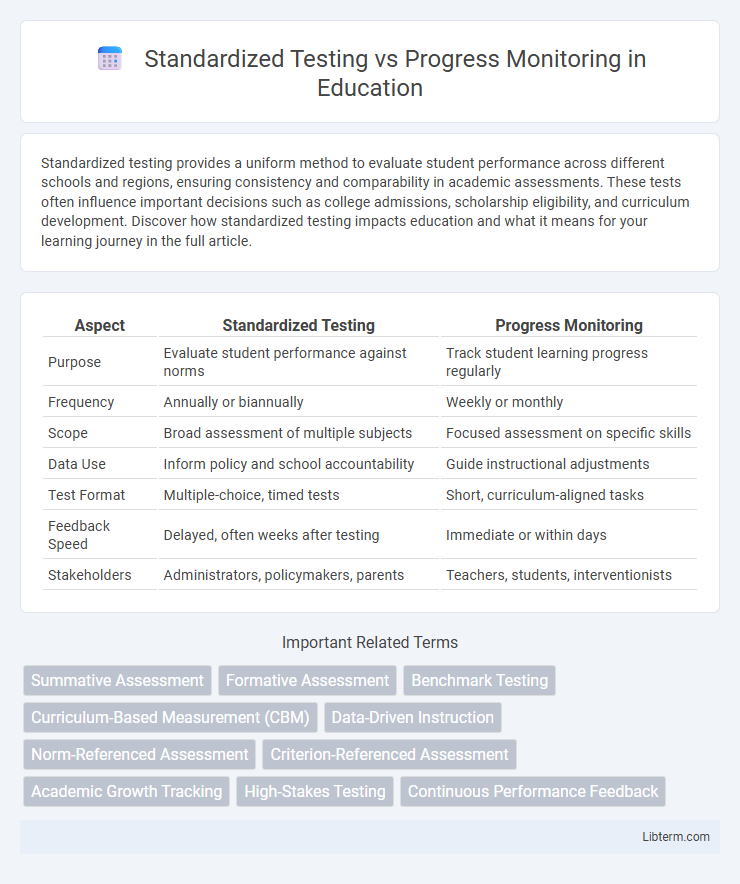Standardized testing provides a uniform method to evaluate student performance across different schools and regions, ensuring consistency and comparability in academic assessments. These tests often influence important decisions such as college admissions, scholarship eligibility, and curriculum development. Discover how standardized testing impacts education and what it means for your learning journey in the full article.
Table of Comparison
| Aspect | Standardized Testing | Progress Monitoring |
|---|---|---|
| Purpose | Evaluate student performance against norms | Track student learning progress regularly |
| Frequency | Annually or biannually | Weekly or monthly |
| Scope | Broad assessment of multiple subjects | Focused assessment on specific skills |
| Data Use | Inform policy and school accountability | Guide instructional adjustments |
| Test Format | Multiple-choice, timed tests | Short, curriculum-aligned tasks |
| Feedback Speed | Delayed, often weeks after testing | Immediate or within days |
| Stakeholders | Administrators, policymakers, parents | Teachers, students, interventionists |
Introduction to Standardized Testing and Progress Monitoring
Standardized testing provides a consistent method to evaluate student performance across large populations through uniform procedures and scoring. Progress monitoring involves frequent, formative assessments that track individual student growth to inform instruction and interventions. Together, these assessment tools support data-driven decision-making in education by combining broad performance benchmarks with detailed growth analysis.
Defining Standardized Testing: Purpose and Methods
Standardized testing serves as a uniform method to evaluate student performance, ensuring consistency across diverse educational settings. Its primary purpose is to measure knowledge, skills, and academic achievement against established benchmarks using multiple-choice or constructed-response formats. These tests are designed to provide objective data that inform policy decisions, identify achievement gaps, and compare student outcomes on a large scale.
What is Progress Monitoring? An Overview
Progress monitoring is a systematic and frequent assessment approach used to evaluate a student's academic performance and growth over time. It involves collecting data at regular intervals to inform instructional decisions, ensuring interventions are effective and tailored to individual needs. Unlike standardized testing, progress monitoring provides ongoing feedback that helps educators adjust teaching strategies promptly to support continuous student improvement.
Key Differences Between Standardized Testing and Progress Monitoring
Standardized testing involves assessing students at fixed points using uniform procedures to compare performance across populations, while progress monitoring tracks individual student growth continuously to inform instruction. Standardized tests provide broad, summative data reflecting overall achievement, whereas progress monitoring offers frequent, formative insights for timely intervention. The key difference lies in their purpose: standardized testing evaluates long-term outcomes, and progress monitoring supports immediate instructional adjustments.
Advantages of Standardized Testing in Education
Standardized testing provides uniform metrics that enable educators and policymakers to objectively compare student performance across different schools and regions, facilitating data-driven decision making. These assessments offer comprehensive benchmarks that help identify achievement gaps and inform curriculum improvements on a broad scale. Consistent administration and scoring of standardized tests ensure reliability and fairness, making them valuable tools for accountability in education systems.
Benefits of Progress Monitoring for Student Growth
Progress monitoring offers real-time data on student performance, enabling tailored instructional adjustments that promote continuous academic growth. It identifies specific learning gaps early, facilitating targeted interventions that boost student achievement and engagement. Frequent assessment through progress monitoring fosters a responsive educational environment that supports personalized learning and improves overall student outcomes.
Limitations and Criticisms of Standardized Testing
Standardized testing faces criticism for its limited ability to capture individual student growth and diverse learning styles, often leading to a narrow focus on test-taking skills rather than comprehensive understanding. Its infrequent administration restricts timely feedback, hindering educators' ability to adjust instruction based on student needs. Additionally, standardized tests can exacerbate educational inequities by disproportionately affecting students from marginalized backgrounds due to cultural bias and resource disparities.
Challenges Associated with Progress Monitoring
Progress monitoring faces challenges such as time-intensive data collection and analysis that can strain educators' resources, reducing instructional time. Variability in student performance and assessment conditions can lead to inconsistent data, complicating accurate interpretation and decision-making. Ensuring fidelity and teacher training in progress monitoring tools is critical to obtaining reliable and actionable insights for personalized instruction.
Integrating Both Approaches for Optimal Assessment
Combining standardized testing and progress monitoring enhances the accuracy of student assessment by leveraging the broad benchmarking of standardized tests alongside the continuous, real-time insights from progress monitoring tools. This integration supports data-driven instruction tailored to individual learning needs and timely interventions, promoting improved academic outcomes. Schools implementing both strategies can balance comprehensive performance evaluation with ongoing progress tracking to optimize educational effectiveness.
Future Trends in Educational Assessment
Future trends in educational assessment emphasize integrating adaptive technology to enhance the precision of both standardized testing and progress monitoring. Data analytics and artificial intelligence increasingly enable real-time, personalized insights into student performance, supporting more dynamic and formative evaluations. Emerging models prioritize continuous assessment over single-point testing, optimizing educational outcomes through timely interventions and tailored learning pathways.
Standardized Testing Infographic

 libterm.com
libterm.com